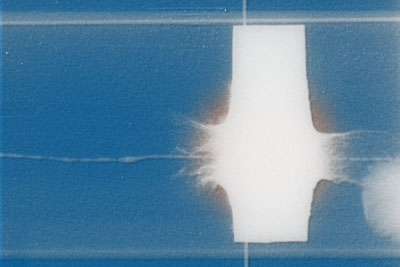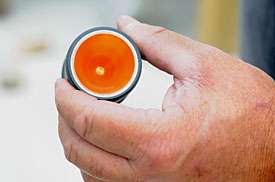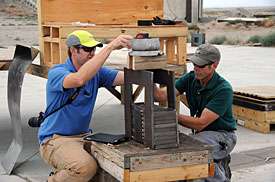Flash X-ray system reveals explosives damage

Far out in the eastern Idaho desert, four men crowd behind a half-buried bunker and wait. James Schondel, a burly man with a thick mustache, leans over what looks like a lunch box with a long white wire attached to it. He yells, "Fire in the hole!" before pressing a button on the box. The resulting "BOOM!" shakes the ground and feels like a pound to the chest even on the far side of the bunker. At INL, unique testing grounds and expertise align to combat contemporary national security challenges.
This is the team of Idaho National Laboratory (INL) explosives experts, materials scientists and armor researchers who work in unique conditions amidst the sagebrush and tumbleweeds to study explosives and armor technology that could protect war fighters and enhance national security.
Today the researchers are using a new capability that could aid the design of stronger armor for U.S. troops. By seeing through smoke and fire, INL's newly implemented flash X-ray system can reveal how a projectile or weapon interacts with armor at the exact moment of impact. This approach allows researchers to form a better understanding of the complex and high-speed interactions between weapons and armor.
This day of testing is dedicated to learning about the formation and flight of a specific weapon. "The reason we do this is because we have to calibrate a weapon, then we design the armor to counter it," said Henry Chu, an armor specialist and the senior researcher at the site today. "[First] we've got to know what we are up against. We need to see through all the smoke and flashes to see what is going on."
In modern warfare, military vehicles use enormous armored panels to defend against weapons. But boosting protection by adding more steel eventually makes equipment too heavy to use, said Jeff Lacy, an armor researcher who operates the flash X-ray system. There are other ways to defend against a weapon, he said, besides trying to stop it with just mass; smarter, more economic ways that are waiting to be discovered.
The team is looking at ways to create lightweight, cost-effective armored material that is still high performance in combat. The armor specialists are also trying to find new ways to "defeat" weapons when they contact an armored surface. But in order to determine what those defeat mechanisms are, the researchers must understand the physics of the weapon itself. That is where the flash X-ray becomes important.
Freezing a bullet
Unlike a high-speed camera, the flash X-ray can penetrate smoke, wood and other low-density materials to photograph the exact moment when a weapon pierces a target.
"An X-ray is an old technology that [generates] a high-energy wave to travel through low-density stuff like air, smoke and fireballs and can see what is going on inside a blast event," said Lacy. While X-ray technology might be old, this particular piece of equipment is very powerful. The flash X-ray is "dumping 6000 amps at 450,000 volts in only 25 nanoseconds," he said. "That's very modern technology, and very cool." It is this kind of power that gives the researchers the ability to see when a bullet hits armor.
Today the team is taking photos of copper "jets" shot from a shaped charge. A shape charge is the inner explosive device that can be found in a variety of military weapons and also commercial mining and drilling operations. The shape charge is a copper lining in the shape of a cone that is surrounded on one side with explosive material. When the explosive detonates, the copper cone collapses in upon itself to form a long, incredibly fast jet that can penetrate several inches of armor steel.
The crew wants to capture an image of the jet in flight, before it rams into the layers of armored steel they stacked as a target directly below. To do this, the X-ray must be timed perfectly. A silver-coated paper screen triggers the X-ray. When the jet pierces through the screen, it sends a signal to trigger the flash X-ray. To set it off at just the right moment, Lacy sets the flash X-ray to fire at 7.5 microseconds (7.5 millionths of a second) after the shape charge penetrates the trigger screen to catch it in midflight.
The X-rays penetrate low density material like wood, smoke or fire, but are blocked by high-density material such as copper. The rays that penetrate the lighter materials energize a special phosphorescent film—exactly like the kind dentists use to take X-rays of your teeth—which creates an image. The image that appears is made up of shadows of the dense materials, so the copper jet shows up as a black streak and low density materials don't show up at all (or appear grey).
Once all the preparations are in place at the test range site, the test pad is cleared and everyone hustles behind the bunker. Lacy fires up the flash X-ray while Schondel, the explosives expert, stations himself at the ignition box. When the flash X-ray is ready, Schondel fires the shape charge, sending a booming shock through the air.
The team emerges from the bunker to examine the steel target—there is no sign of the shape charge. What remains is a copper-lined hole where the jet disappeared into the stacked steel plates.
"With normal [research] methods you can see before you hit the detonator button, and you can see the hole it made later, but you can't see what is going on with the weapon," said Lacy while he inspects the hole.
Captured in flight
Chu grabs the film out of protective metal plating and scans it into his computer. He watches as a grainy grey and white image appears—a long broken line floating above a black block.

"You can see that the jet is a stream of high-temperature copper particles, roughly about 600 degrees centigrade," said Chu, pointing at the long line on the computer screen. It is very hot, but it is not molten like most people think—it is actually a stream of particles that is broken up, not in a continuous stream."
Understanding how the copper behaves in flight could reveal opportunities for defeating this powerful weapon. Right now, these types of munitions cause a lot of damage to barriers and armored vehicles.

Comparing the images with the depth of penetration into the steel targets, the researchers gain insight into material behavior of the steel, explained Ben Langhorst, an INL materials scientist. He works hand-in-hand with fellow scientist Michael Bakas, who works in the laboratory to pick out and design new armor materials.
In the laboratory, the researchers will analyze the armor's performance based on how the projectile gets broken up, shatters or stays intact. By looking at images taken before, during and after a projectile, such as a bullet, hits the steel, Langhorst can determine the velocity of the projectile, and how much energy it lost going through the target. Shattering a projectile, bending it or stopping it altogether are all different ways the material is changing the energy, or power, of the projectile. INL researchers are looking at how these characteristics between the different outcomes (like shattering versus bending) could help defense strategies.
Knowing how armor fails against weapons brings the scientists closer to designing a material that can withstand such lethal forces in the field of duty.
"The engineering challenges are exciting, and being able to incorporate bombs and bullets into your work is always fun," said Langhorst with a sly grin, "especially when it is scientific in nature."
Provided by Idaho National Laboratory


















